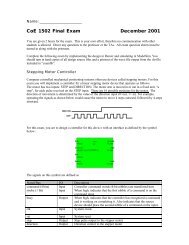Discovering critical residues in glutathione reductase - Gentoo
Discovering critical residues in glutathione reductase - Gentoo
Discovering critical residues in glutathione reductase - Gentoo
Create successful ePaper yourself
Turn your PDF publications into a flip-book with our unique Google optimized e-Paper software.
Figure 4: Ile26 <strong>in</strong> FAD b<strong>in</strong>d<strong>in</strong>g. See text for discussion.<br />
Initial analysis focused on the active site, where there is already a long list<br />
of <strong>residues</strong> suspected important <strong>in</strong> b<strong>in</strong>d<strong>in</strong>g and catalysis. Near the NADPH<br />
(Figure 3), one can see that many of the expected <strong>residues</strong> were conserved:<br />
Arg291, Glu201, and others. But there are more conserved <strong>residues</strong>: Ser177,<br />
Asp178, Gln445, and <strong>in</strong>terest<strong>in</strong>gly, Ile198. Ser177 appears to hydrogen bond<br />
with the nicot<strong>in</strong>amide r<strong>in</strong>g, which may serve to orient it correctly for hydride<br />
transfer. It's already known that generally the positive residue of ion pairs is<br />
nearer to the flav<strong>in</strong>, but what grows more clear here is that there are conserved<br />
positive <strong>residues</strong> above the flav<strong>in</strong> (Gln445 and Arg291 on the NADPH side), and<br />
the conserved negative Asp178 below the flav<strong>in</strong>. This negative charge just below<br />
the carbon that accepts a hydride from NADPH may serve some purpose <strong>in</strong>
















